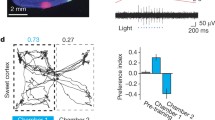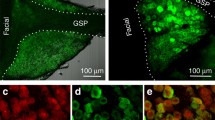Summary
The responses of 80 amygdaloid neurons to the four basic taste (sucrose, NaCl, HCl and quinine hydrochloride), thermal (5° C, 20° C and 40° C) and tactile (brushing) stimuli applied to the anterior part of the tongue were recorded in anesthetized rats. About 90% of the taste-sensitive amygdaloid neurons responded to thermal and/or tactile stimulations of the tongue as well, and some of them showed convergent responses to tactile stimulation of various parts of the body and to acoustic stimulation. Most (86%) amygdaloid taste-sensitive neurons showed a phasic pattern of excitatory response lasting 1–2 s after onset of stimulation with the broad breadth of tuning to the four taste stimuli. About 35% of the neurons showed monotonic increasing responses with increasing NaCl concentration. The rest of the neurons showed complex intensity-response function. The amygdaloid neurons could be grouped into classes based on their best responsive stimulus, and the response profiles of those neurons showed relative regularity when the four stimuli were hedonically ordered from most to least preferred (i.e., sucrose, NaCl, HCl, quinine). Across-neuron correlations between magnitudes of responses to pairs of the four basic taste stimuli have suggested a tendency that taste information is processed in a hedonic dimension in the amygdala. The neurons in the central (Ce) nucleus showed some differential taste responses from those in other amygdaloid nuclei, i.e., about half of the Ce neurons showed tonic responses, and the across-neuron correlation coefficients in the Ce neurons were much higher than those in the non-Ce neurons.
Similar content being viewed by others
References
Azuma S (1983) Response characteristics of amydaloid taste sensitive neurons in the rat. Jpn J Oral Biol 25: 116–129 (in Japanese)
Ben-Ari Y, Le Gal la Salle G, Champagnat JC (1974) Lateral amygdala unit activity: I. Relationship between spontaneous and evoked activity. Electroencephalogr Clin Neurophysiol 37: 449–461
Block CH, Schwartzbaum JS (1983) Ascending efferent projections of the gustatory parabrachial nuclei in the rabbit. Brain Res 259: 1–9
Box BM, Mogenson GJ (1975) Alterations in ingestive behaviors after bilateral lesions of the amygdala in the rat. Physiol Behav 15: 679–688
Cain DP, Bindra D (1972) Responses of amygdala single units to odors in the rat. Exp Neurol 35: 98–110
Dell P, Olson R (1951) Projections “secondaires” mesencephaliques, diencephaliques et amygdaliennes des afferences viscerales vagales. Soc Biol Comp Rendus 145: 1088–1091
Di Lorenzo PM, Schwartzbaum JS (1982) Coding of gustatory information in the pontine parabrachial nuclei of the rabbit: Magnitude of neural response. Brain Res 251: 229–244
Doetsch GS, Erickson RP (1970) Synaptic processing of tastequality information in the nucleus tractus solitarius of the rat. J Neurophysiol 33: 490–507
Erickson RP (1963) Sensory neural patterns and gustation. In: Zotterman Y (ed) Olfaction and taste I. Pergamon Press, Oxford, pp 205–213
Fonberg E (1969) Effects of small dorsomedial amygdala lesions on food intake and acquisition of instrumental alimentary reactions in dogs. Physiol Behav 4: 739–743
Frank M (1973) An analysis of hamster afferent taste nerve response functions. J Gen Physiol 61: 588–618
Frank M (1974) The classification of mammalian afferent taste nerve fibers. Chem Senses Flavor 1: 53–60
Funakoshi M, Ninomiya Y (1983) Relations between the spontaneous firing rate and taste responsiveness of the dog cortical neurons. Brain Res 262: 155–159
Kemble ED, Schwartzbaum JS (1969) Reactivity to taste properties of solutions following amygdaloid lesions. Physiol Behav 4: 981–985
Kiefer SW, Grijalva CV (1980) Taste reactivity in rats following lesions of the zona incerta or amygdala. Physiol Behav 25: 545–554
Koikegami H (1963) Amygdala and other related limbic structures; experimental studies on the anatomy and function. I. Anatomical researches with some neurophysiological observations. Acta Med Biol (Niigata) 10: 161–277
König JFR, Klippel RA (1963) The rat brain. Williams and Wilkins, Baltimore
Krettek JE, Price JL (1978) A description of the amygdaloid complex in the rat and cat with observations on intraamygdaloid axonal connections. J Comp Neurol 178: 255–280
Lasiter PS, Glanzman DL (1982) Cortical substrates of taste aversion learning: Dorsal prepiriform (insular) lesions disrupt taste aversion learning. J Comp Physiol Psychol 96: 376–392
Machne X, Segundo JP (1956) Unitary responses to afferent volleys in amygdaloid complex. J Neurophysiol 19: 232–240
Mehler WR, Pretorius JK, Phelan KD, Mantyh PW (1981) Diencephalic afferent connections of the amygdala in the squirrel monkey with observations and comments on the cat and rat. In: Ben-Ari Y (ed) The amygdaloid complex. Elsevier, Amsterdam, pp 105–120
Nachman M, Ashe JH (1974) Effects of basolateral amygdala lesions on neophobia, learned taste aversions and sodium appetite in rats. J Comp Physiol Psychol 87: 622–643
Ninomiya Y, Funakoshi M (1982) Relationships between spontaneous discharge rates and taste responses of the dog thalamic neurons. Brain Res 242: 67–76
Nitecka L, Amerski L, Narkiewicz O (1981) The organization of intraamygdaloid connections; an HRP study. J Hirnforsch 22: 3–7
Nomura S, Mizuno N, Matsuda K, Sugimoto T, Nakamura Y (1979) Localization of parabrachial nucleus neurons projection to the thalamus or the amygdala in the cat using horseradish peroxidase. Exp Neurol 64: 375–385
Norgren R (1974) Gustatory afferents to ventral forebrain. Brain Res 81: 285–295
Norgren R (1976) Taste pathways to hypothalamus and amygdala. J Comp Neurol 166: 17–30
Norgren R, Grill HJ (1976) Efferent distribution from the cortical gustatory area in rats. Neuroscience Abst 2: 124
O'Keefe J, Bouma H (1969) Complex sensory properties of certain amygdala units in the freely moving cat. Exp Neurol 23: 384–398
Ottersen OP (1982) Connections of the amygdala of the rat. IV. Corticoamygdaloid and intraamygdaloid connections as studied with axonal transport of horseradish peroxidase. J Comp Neurol 205: 30–48
Ottersen OP, Ben-Ari Y (1979) Afferent connections to the amygdaloid complex of the rat and cat. I. Projections from the thalamus. J Comp Neurol 187: 401–424
Perrotto RS, Scott TR (1976) Gustatory neural coding in the pons. Brain Res 110: 283–300
Pfaffmann C (1955) Gustatory nerve impulses in rat, cat and rabbit. J Neurophysiol 18: 429–440
Rolls BJ, Rolls ET (1973a) Effects of lesions in the basolateral amygdala on fluid intake in the rat. J Comp Physiol Psychol 83: 240–247
Rolls ET, Rolls BJ (1973b) Altered food preferences after lesions in the basolateral region of the amygdala in the rat. J Comp Physiol Psychol 83: 248–259
Sanghera MK, Rolls ET, Roper-Hall A (1979) Visual responses of neurons in the dorsolateral amygdala of the alert monkey. Exp Neurol 63: 610–626
Saper CB (1982) Convergence of autonomic and limbic connections in the insular cortex of the rat. J Comp Neurol 210: 163–173
Sato M, Ogawa H, Yamashita S (1975) Response properties of macaque monkey chorda tympani fibers. J Gen Physiol 66: 781–810
Sawa M, Delgado JMR (1963) Amygdala unitary activity in the unrestrained cat. Electroencephalogr Clin Neurophysiol 15: 637–650
Schwartzbaum JS, Morse JR (1978) Taste responsivity of amygdaloid units in behaving rabbit: A methodological report. Brain Res Bull 3: 131–141
Scott TR, Erickson RP (1971) Synaptic processing of taste-quality information in thalamus of the rat. J Neurophysiol 34: 868–884
Scott TR, Yalowitz MS (1978) Thalamus taste responses to changing stimulus concentration. Chem Senses Flavor 3: 167–175
Smith DV, Travers JB (1979) A metric for the breadth of tuning of gustatory neurons. Chem Senses Flavor 4: 215–229
Travers JB, Smith DV (1979) Gustatory sensitivities in neurons of the hamster nucleus tractus solitarius. Sensory Processes 3: 1–26
Turner BH (1981) The cortical sequence and terminal distribution of sensory related afferents to the amygdaloid complex of the rat and monkey. In: Ben-Ari Y (ed) The amygdaloid complex. Elsevier, Amsterdam, pp 51–62
Turner BH, Herkenham M (1981) An autoradiographic study of thalamo-amygdaloid connections in the rat. Anat Rec 199: 260A
Van Buskirk RL, Smith DV (1981) Taste sensitivity of hamster parabrachial pontine neurons. J Neurophysiol 45: 144–171
Veening JG (1978) Subcortical afferents of the amygdaloid complex in the rat: An HRP study. Neurosci Lett 8: 197–202
Yamamoto T, Kawamura Y (1978) Response characteristics of cortical taste cells and chorda tympani fibers in the rabbit. Brain Res 152: 586–590
Yamamoto T, Azuma S, Kawamura Y (1981a) Significance of cortical-amygdalar-hypothalamic connections in retention of conditioned taste aversion in rats. Exp Neurol 74: 758–768
Yamamoto T, Azuma S, Kawamura Y (1984a) Functional relations between the cortical gustatory area and the amygdala: Electrophysiological and behavioral studies in rats. Exp Brain Res 56: 23–31
Yamamoto T, Matsuo R, Kawamura Y (1980a) The pontine taste area in the rabbit. Neurosci Lett 16: 5–9
Yamamoto T, Matsuo R, Kawamura Y (1980b) Localization of cortical gustatory area in rats and its role in taste discrimination. J Neurophysiol 44: 440–455
Yamamoto T, Takebe H, Kawamura Y (1981b) A simple device detecting onset time of taste stimulation. Physiol Behav 26: 721–723
Yamamoto T, Yuyama N, Kawamura Y (1981c) Central processing of taste perception. In: Katsuki Y, Norgren R, Sato M (eds) Brain mechanisms of sensation. Wiley, New York, pp 197–207
Yamamoto T, Fujiwara T, Matsuo R, Kawamura Y (1982) Hypoglossal motor nerve activity elicited by taste and thermal stimuli applied to the tongue in rats. Brain Res 238: 89–104
Yamamoto T, Yuyama N, Kato T, Kawamura Y (1984b) Gustatory responses of cortical neurons in rats. I. Response characteristics. J Neurophysiol 51: 616–635
Author information
Authors and Affiliations
Rights and permissions
About this article
Cite this article
Azuma, S., Yamamoto, T. & Kawamura, Y. Studies on gustatory responses of amygdaloid neurons in rats. Exp Brain Res 56, 12–22 (1984). https://doi.org/10.1007/BF00237437
Received:
Accepted:
Issue Date:
DOI: https://doi.org/10.1007/BF00237437




